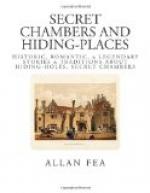A priest’s hole beneath the floor of a small oratory adjoining “the chapel” (now a bedroom) at Borwick Hall, Lancashire, has an opening devised much in the same fashion as that at Oxburgh. By leaning his weight upon a certain portion of the boards, a fugitive could slide into a convenient gap, while the floor would adjust itself above his head and leave no trace of his where-abouts.
[Illustration: ENTRANCE TO HIDING-PLACE, PARHAM HALL, SUSSEX]
Window-seats not uncommonly formed the entrance to holes beneath the level of the floor. In the long gallery of Parham Hall, Sussex, an example of this may be seen. It is not far from “the chapel,” and the officiating priest in this instance would withdraw a panel whose position is now occupied by a door; but the entrance to the hiding-place within the projecting bay of the window is much the same as it ever was. After the failure of the Babington conspiracy one Charles Paget was concealed here for some days.
The Tudor house of Tusmore, in Oxfordshire, also had a secret chamber, approached through a fixed settle in “the parlour” window. A tradition in the neighbourhood says that the great fish-pond near the site of the old house was dug by a priest and his servant in the days of religious persecution, constituting their daily occupation for twelve years!
Paxhill, in Sussex, the ancient seat of the Bordes, has a priest’s hole behind a window-shutter, and it is large enough to hold several persons; there is another large hiding-hole in the ceiling of a room on the ground floor, which is reached through a trap-door in the floor above. It is provided with a stone bench.
In castles and even ecclesiastical buildings sections of massive stone columns have been found to rotate and reveal a hole in an adjacent wall—even an altar has occasionally been put to use for concealing purposes. At Naworth Castle, for instance, in “Lord William’s Tower,” there is an oratory behind the altar, in which fugitives not only could be hidden but could see anything that transpired in its vicinity. In Chichester Cathedral there




